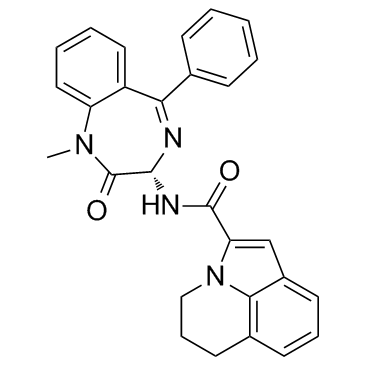Tarazepide
Modify Date: 2025-08-25 15:07:57

Tarazepide structure
|
Common Name | Tarazepide | ||
|---|---|---|---|---|
| CAS Number | 141374-81-4 | Molecular Weight | 448.516 | |
| Density | 1.3±0.1 g/cm3 | Boiling Point | 788.0±60.0 °C at 760 mmHg | |
| Molecular Formula | C28H24N4O2 | Melting Point | N/A | |
| MSDS | N/A | Flash Point | 430.4±32.9 °C | |
Use of TarazepideTarazepide is a potent and specific CCK-A receptor antagonist. |
| Name | Tarazepide |
|---|---|
| Synonym | More Synonyms |
| Description | Tarazepide is a potent and specific CCK-A receptor antagonist. |
|---|---|
| Related Catalog | |
| Target |
CCK-A receptor[1] |
| In Vivo | Tarazepide decreases duodenal electric activity, reduces interdigestive pancreatic secretion, especially protein; reduces cephalic and early postprandial (milk) induced secretion of bicarbonate and protein.Pancreatic protein secretion to intravenous CCK-8 was little affected by atropine, but was significantly reduced by Tarazepide±Atropine; in contrast, protein secretion to intraduodenal CCK-8 was abolished by Tarazepide or atropine[1]. Leptin is administered to the animals at doses of 0.1, 1.0 or 10.0 μg/kg i.d. Tarazepide (2.5 mg/kg, i.d.), a CCK(1) receptor antagonist, is given to the rats prior to the application of leptin. CCK plasma level is measured by radioimmunoassay (RIA) following administration of leptin to the rats. Intraduodenal administration of leptin (1.0 or 10.0 microg/kg) to the fasted rats significantly and dose-dependently increases pancreatic protein and amylase outputs. Pancreatic secretory responses to leptin were totally abolished by prior capsaicin deactivation of sensory nerves or by pretreatment of the rats with Tarazepide[2]. |
| Animal Admin | Calve[1] The 5 to 7-day-old Friesian male calves (42.0±1.5 kg body weight) are used. The study is made on four calves. After recording 2 to 3 preprandial (interdigestive) MMC/PPS cycles, Tarazepide suspension (0.05, 0.5 and 5.0 mg/kg body weight), or vehicle alone (1% methylcellulose) is infused intraduodenally (i.d.). |
| References |
| Density | 1.3±0.1 g/cm3 |
|---|---|
| Boiling Point | 788.0±60.0 °C at 760 mmHg |
| Molecular Formula | C28H24N4O2 |
| Molecular Weight | 448.516 |
| Flash Point | 430.4±32.9 °C |
| Exact Mass | 448.189911 |
| LogP | 3.64 |
| Vapour Pressure | 0.0±2.7 mmHg at 25°C |
| Index of Refraction | 1.713 |
| Storage condition | 2-8℃ |
| (-)-N-[(S)-2,3-Dihydro-1-methyl-2-oxo-5-phenyl-1H-1,4-benzodiazepin-3-yl]-5,6-dihydro-4H-pyrrolo[3,2,1-ij]quinoline-2-carboxamide |
| RK2972YZ2U |
| tarazepide |
| 4H-Pyrrolo[3,2,1-ij]quinoline-2-carboxamide, N-[(3S)-2,3-dihydro-1-methyl-2-oxo-5-phenyl-1H-1,4-benzodiazepin-3-yl]-5,6-dihydro- |
| (-)-N-((S)-2,3-Dihydro-1-methyl-2-oxo-5-phenyl-1H-1,4-benzodiazepin-3-yl)-5,6-dihydro-4H-pyrrolo(3,2,1-ij)quinoline-2-carboxamide |
| N-[(3S)-1-Methyl-2-oxo-5-phenyl-2,3-dihydro-1H-1,4-benzodiazepin-3-yl]-5,6-dihydro-4H-pyrrolo[3,2,1-ij]quinoline-2-carboxamide |